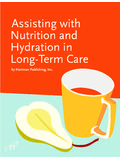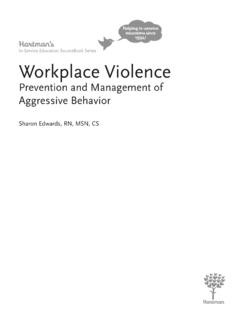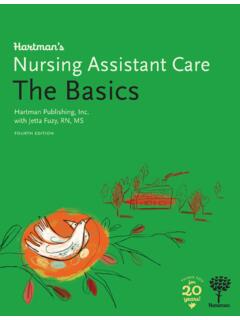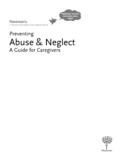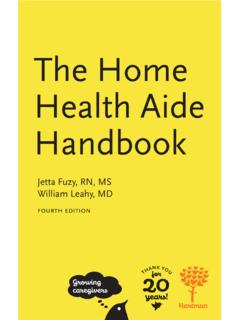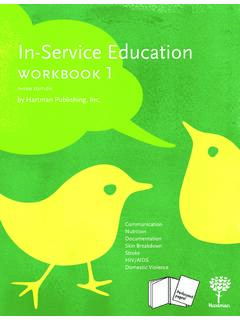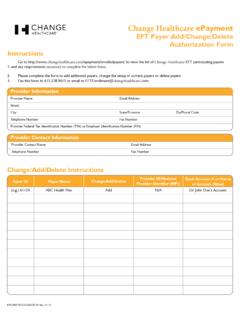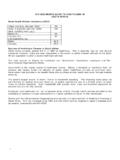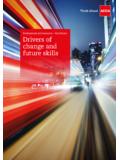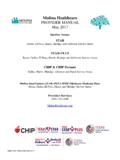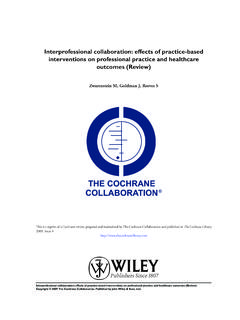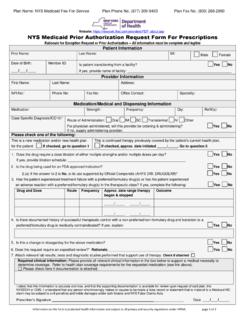Transcription of Working Safely Body Mechanics in Healthcare
1 Helping in-service educators since 1994!Hartman's In-Service Education SourceBook SeriesWorking SafelyBody Mechanics in Healthcare Albuquerque, NMWorking SafelyBODY MECHANICSin Health CareThis material is the result of the hard work ofmany people, including editors, peer reviewers,and the publisher. There is no single publisher gratefully acknowledges the following individualswho contributed to this material:Joan GreeneEducation CoordinatorCentral Alabama Home HealthMontgomery, ALKaren A. Hergert, RN, MSDirector of Staff EducationMaristhill Nursing HomeWaltham, MAAnn M. McCloskey, RNStaff DevelopmentLafayette RedeemerPhiladelphia, PABarbara PetersonStaff Development CoordinatorMount Loretto Nursing HomeAmsterdam, NYMary C. Reed, RN, MSStaff Development InstructorOur Lady of Mercy Life CenterGuilderland, NYJanet SonnenbergCoordinator of CNA TrainingWestshire Care CenterOrlando Park, ILPaula L. Windler, RN, MS, CLNCC handler, AZNOTICE TO THE READERT hough the guidelines contained in this text are based onconsultations with Healthcare professionals, they should not beconsidered absolute recommendations.
2 The instructor and readersshould follow employer, local, state, and federal guidelinesconcerning Healthcare practices. These guidelines change, and it isthe reader's responsibility to be aware of these changes and of thepolicies and procedures of her or his Healthcare publisher, author, editors, and reviewers cannotaccept any responsibility for errors or omissions or for anyconsequences from application of the information in this book andmake no warranty, express or implied, with respect to the contentsof this does not warrant or guarantee any of theproducts described herein or perform any analysis in connectionwith any of the product information contained Editors: Micki Heskett, Scrivenor Ink Celia McIntireCopy Editor: Susan AlvareDesign: John W. DavisComposition: Celia McIntireIllustration: Thaddeus CastilloISBN 1-888343-15-X 1998 Hartman Publishing, Inc. All rightsreserved. Limited permission to photocopy thelabeled handouts in this text is granted to directpurchasers of this book from the publisher.
3 Copiescan only be made for employees or students atONE LOCATION of a multi-site employer orschool. No other part of this book may bereproduced, in any form or by any means,without permission in writing from the of ContentsFYI5 Learning Objective 4: DemonstrateIntroduction and Assessment7 Handouts:Assessment (8)Assessment Answer Key (10)Key Terms (11)Note-Taking Worksheet (12)Learning Objective 1: Identify themost common causes of injury tohealthcare workers16 Transparencies:Hazards That Lead to Injury (18)Facts About Healthcare Worker Injuries (19)Most Difficult Resident/Client Handling Tasks (20)Handouts:Facts About Healthcare Worker Injuries (21)Learning Objective 2: Define goodbody Mechanics and related terms22 Transparencies:What Does "Body Mechanics " Mean? (24)Understanding the Spine (25)Understanding the Muscles (26)Maintaining Good Posture and Health (27)The ABC's of Good Body Mechanics (28)Handouts:The ABC's of Good Body Mechanics (29)Learning Objective 3: Demonstratethe rules of proper body mechanics30 Transparencies:Think First!
4 (33)The Ten Rules of Proper Body Mechanics (34)Body Mechanics Checklist (37)Handouts:The Ten Rules of Proper Body Mechanics (35)Body Mechanics Checklist (36)the use of proper body mechanicsfor resident/client body positioning38 Transparencies:Review of Body Positioning Terms (40)Preparing for Any Body Positioning Task orTransfer (42)Assisting with Resident/Client Body Positioning(47)Handouts:Preparing for Any Body Positioning Task orTransfer (41)Assisting with Resident/Client Body Positioning(43)Learning Objective 5: Demonstratethe use of proper body mechanicsfor transfers48 Transparencies:Types of Transfers (50)Guidelines for Using a Mechanical Lift (54)Handouts:Assisting in Resident/Client Transfers (51)Learning Objective 6: List ways topractice proper body mechanicswhen assisting with activities ofdaily living (ADLs)55 Transparencies:General Suggestions for Assisting in ADLs (56)Tips for Assisting in ADLs (59)Handouts:Tips for Assisting in ADLs (57)Learning Objective 7: List ways toadapt the home for safer bodymechanics60 Handout:Adapting the Home (61)Learning Objective 8: Demonstrateproper body Mechanics duringambulation and while assisting afalling person62 Transparencies:Using a Cane to Assist with Ambulation (66)Using a Walker to Assist with Ambulation (67)Factors that Contribute to Falls (69)Handouts:Assisting the Resident/Client with Ambulation (64)Assisting a Falling Person (68)Learning Objective 9: Demonstrateseveral safe strength and stretchingexercises70 Transparencies:Four Ways of Maintaining Fitness (72)The Value of Regular Exercise (74)Practicing Posture (75)Handouts:Group Stretching (73)Strength-Building Exercises (76)Learning Objective 10: Demonstratethe proper way to use facilityequipment when assisting withtransfers77 Learning Objective 11: List facilityrules on proper transfers78 Closing and Skills Demonstrations79 Handout.
5 Checklists for Skills Demonstrations (80)References85In-Service Evaluation Form86 Certificate of Completion87 Record Keeping Form88 For More Information89 5 RFYI esearch shows that nursing assistants andunfortunate, since mechanical lift devices are meanthome health aides have a high probabilityto make lifting and transferring easier and safer forof experiencing lower back pain and/orall concerned. These are all problems that can beinjury due to the strains of transferring clients oraddressed in this in-service, as and the improper use of body lesson plan is organized by learningMany para-professionals perceive an aching backobjectives. Each learning objective has its ownas a standard physical stress of their job. Thelesson plan with learning activities. Along with thepurpose of this in-service is to highlight activitieslesson plan, we provide teaching tools, includingthat research indicates are frequently dangeroustransparency masters, handouts, and to correct poor lifting and transferringThese teaching tools are referenced in the lessontechniques by demonstrating proper You may choose to use some or all of theseAdopting simple methods in lifting and transferringtools in your presentation.
6 Every in-servicehas several benefits, from decreasing back pain toeducator should be able to tailor this material to fitbuilding lower back strength. This in-service willthe needs of their students and facility or you how to ease the physical stresses yourTo use the transparency master, convert themaides and assistants experience every day andto acetates for use with an overhead projector. Ifreduce their potential for projection is not convenient in yourIt is important to note here that back belts arepresentation area, copy the information from theNOT endorsed by the National Institute fortransparency masters onto a chalkboard or flipOccupational Safety and Health (NIOSH) as anchart. injury-prevention measure. In a two-year studyTo use handouts, photocopy the numberconducted by the Back Belt Working Group ofneeded for your group. Consider using differentNIOSH, back belts were shown to provide nocolors of paper to organize the different handoutsprotection against injury resulting from repeatedor to make some stand out.
7 Limited permission islifting, pushing, pulling, twisting, or bending. Thisgranted to photocopy the handouts for use at thefinding may be due to the fact that many peoplesite originally purchasing this that by wearing a back belt they do notPhotocopying other parts of this in-service,have to pay attention to good body the lesson plan, is expressly belts do not take the place of proper bodyBecause the in-service covers a lot of material, Mechanics !you may wish to divide your presentation into aAnother problem that can affect the practice offew different in-services. We do stronglygood body Mechanics in nursing homes andrecommend that the first three learning objectiveshospitals is that often these facilities arebe presented prior to any portion of the transferunderstaffed or unable to invest in enoughsection. mechanical lifts to go around. In a studySome additional resources on body mechanicsconducted by Garg, et al. (see References section,and transferring can be ordered from variouspage 85) the researchers discovered that many ofagencies and organizations.
8 We include orderthe employees they surveyed don't use theforms in this in-service to request these devices anyway, for a number ofWe hope you find this in-service helpful, and,reasons: they considered the devices to be tooas always, your comments and suggestions aretime-consuming, unsafe for themselves and thevery in their care, or in poor repair. Many ofthem didn't even know how to use the devices inthe first place. All of these problems areHappy Teaching!Introduction and Assessment 7 Introduction and Assessment Estimated Time:15-20 MinutesTools:Handout Intro-1 AssessmentHandout Intro-2 Assessment Answer KeyHandout Intro-3 Key TermsHandout Intro-4 Note-Taking WorksheetLearning Activity:DiscussionDistributeHandout Intro-1 AssessmentAllow 5 minutes to Intro-2 AssessmentAnswer Key Review the correct answers. Ask if the assessment unveiled any important issues theparticipants would like to cover in this session. Discuss participants' expectations andneeds before the in-service rather than afterward in an evaluation.
9 If the group isreluctant to speak, try one of the following discussion lead ins: How many of you ache at the end of a typical work day. Why? How many exercise regularly? How often? What type of exercise? What items on the pre-test did you answer incorrectly? Share a few transfer or lifting nightmares. Review your accident and injury logs. Identify the "trouble spots" and presentthem to participants. Ask for any additions they have to your Intro-3 Key TermsandHandout Intro-4 Note-TakingWorksheetTell participants to take notes during class to help them arrange and remember theinformation. They may want to refer to the Key Terms handout throughout the in-service for definitions of important Intro-1 8 Assessment Name: _____ Date: _____Fill in the each of the following statements with the appropriate word or words from the word bank. Use eachword only once. Some of the words will not be body Mechanics is important to prevent _____ and performing _____ it is very important to have good body largest and strongest muscles in the body are located in the _____ human's base of support are the at the _____ is never a good idea when lifting heavy or T (true) or F (false) for each of the following If my back doesn't hurt, I must be doing everything correctly.
10 Back pain is When lifting heavy objects, it is best to lift quickly and turn by twisting the upper body. If you know your body, almost everything can be lifted alone. Pulling residents or clients out of bed is better than lifting them. The person you are transferring should relax while you move him or her. The lower back is your most important body part. Being overweight doesn't affect lifting or transferring. Residents or clients should stretch before you lift them. Abdominal muscles support your spine when you lift. Base of Support is an alternative rock and roll band. Good posture is also known as body alignment. The natural curves of the spine are the cervical, thoracic, and lumbar curves. The muscles in the hands are used to lift heavy objects. Bending from the waist prevents strains and fatigue. Good bed positioning will help a resident or client maintain joint range of motion.

